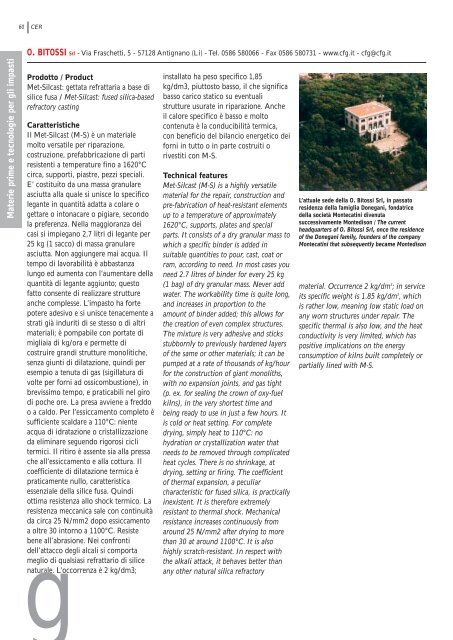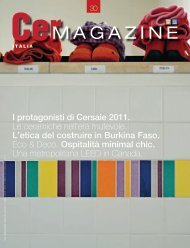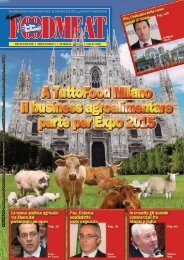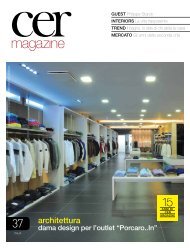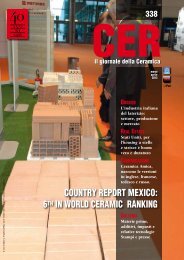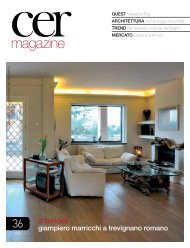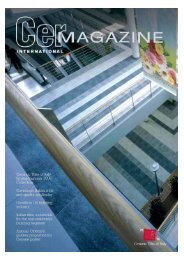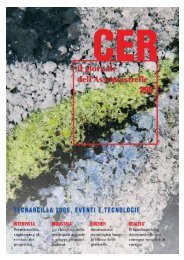Cer - Pool.mo.it
Cer - Pool.mo.it
Cer - Pool.mo.it
You also want an ePaper? Increase the reach of your titles
YUMPU automatically turns print PDFs into web optimized ePapers that Google loves.
60 CER<br />
Materie prime e tecnologie per gli impasti<br />
O. BITOSSI Srl - Via Fraschetti, 5 - 57128 Antignano (Li) - Tel. 0586 580066 - Fax 0586 580731 - www.cfg.<strong>it</strong> - cfg@cfg.<strong>it</strong><br />
Prodotto / Product<br />
Met-Silcast: gettata refrattaria a base di<br />
silice fusa / Met-Silcast: fused silica-based<br />
refractory casting<br />
Caratteristiche<br />
Il Met-Silcast (M-S) è un materiale<br />
<strong>mo</strong>lto versatile per riparazione,<br />
costruzione, prefabbricazione di parti<br />
resistenti a temperature fino a 1620°C<br />
circa, supporti, piastre, pezzi speciali.<br />
E’ cost<strong>it</strong>u<strong>it</strong>o da una massa granulare<br />
asciutta alla quale si unisce lo specifico<br />
legante in quant<strong>it</strong>à adatta a colare o<br />
gettare o intonacare o pigiare, secondo<br />
la preferenza. Nella maggioranza dei<br />
casi si impiegano 2,7 l<strong>it</strong>ri di legante per<br />
25 kg (1 sacco) di massa granulare<br />
asciutta. Non aggiungere mai acqua. Il<br />
tempo di lavorabil<strong>it</strong>à è abbastanza<br />
lungo ed aumenta con l’aumentare della<br />
quant<strong>it</strong>à di legante aggiunto; questo<br />
fatto consente di realizzare strutture<br />
anche complesse. L’impasto ha forte<br />
potere adesivo e si unisce tenacemente a<br />
strati già indur<strong>it</strong>i di se stesso o di altri<br />
materiali; è pompabile con portate di<br />
migliaia di kg/ora e permette di<br />
costruire grandi strutture <strong>mo</strong>nol<strong>it</strong>iche,<br />
senza giunti di dilatazione, quindi per<br />
esempio a tenuta di gas (sigillatura di<br />
volte per forni ad ossicombustione), in<br />
brevissi<strong>mo</strong> tempo, e praticabili nel giro<br />
di poche ore. La presa avviene a freddo<br />
o a caldo. Per l’essiccamento completo è<br />
sufficiente scaldare a 110°C: niente<br />
acqua di idratazione o cristallizzazione<br />
da eliminare seguendo rigorosi cicli<br />
termici. Il r<strong>it</strong>iro è assente sia alla pressa<br />
che all’essiccamento e alla cottura. Il<br />
coefficiente di dilatazione termica è<br />
praticamente nullo, caratteristica<br />
essenziale della silice fusa. Quindi<br />
ottima resistenza allo shock termico. La<br />
resistenza meccanica sale con continu<strong>it</strong>à<br />
da circa 25 N/mm2 dopo essiccamento<br />
a oltre 30 intorno a 1100°C. Resiste<br />
bene all’abrasione. Nei confronti<br />
gdell’attacco degli alcali si comporta<br />
meglio di qualsiasi refrattario di silice<br />
naturale. L’occorrenza è 2 kg/dm3;<br />
installato ha peso specifico 1,85<br />
kg/dm3, piuttosto basso, il che significa<br />
basso carico statico su eventuali<br />
strutture usurate in riparazione. Anche<br />
il calore specifico è basso e <strong>mo</strong>lto<br />
contenuta è la conducibil<strong>it</strong>à termica,<br />
con beneficio del bilancio energetico dei<br />
forni in tutto o in parte costru<strong>it</strong>i o<br />
rivest<strong>it</strong>i con M-S.<br />
Technical features<br />
Met-Silcast (M-S) is a highly versatile<br />
material for the repair, construction and<br />
pre-fabrication of heat-resistant elements<br />
up to a temperature of approximately<br />
1620°C, supports, plates and special<br />
parts. It consists of a dry granular mass to<br />
which a specific binder is added in<br />
su<strong>it</strong>able quant<strong>it</strong>ies to pour, cast, coat or<br />
ram, according to need. In <strong>mo</strong>st cases you<br />
need 2.7 l<strong>it</strong>res of binder for every 25 kg<br />
(1 bag) of dry granular mass. Never add<br />
water. The workabil<strong>it</strong>y time is qu<strong>it</strong>e long,<br />
and increases in proportion to the<br />
a<strong>mo</strong>unt of binder added; this allows for<br />
the creation of even complex structures.<br />
The mixture is very adhesive and sticks<br />
stubbornly to previously hardened layers<br />
of the same or other materials; <strong>it</strong> can be<br />
pumped at a rate of thousands of kg/hour<br />
for the construction of giant <strong>mo</strong>nol<strong>it</strong>hs,<br />
w<strong>it</strong>h no expansion joints, and gas tight<br />
(p. ex. for sealing the crown of oxy-fuel<br />
kilns), in the very shortest time and<br />
being ready to use in just a few hours. It<br />
is cold or heat setting. For complete<br />
drying, simply heat to 110°C: no<br />
hydration or crystallization water that<br />
needs to be re<strong>mo</strong>ved through complicated<br />
heat cycles. There is no shrinkage, at<br />
drying, setting or firing. The coefficient<br />
of thermal expansion, a peculiar<br />
characteristic for fused silica, is practically<br />
inexistent. It is therefore extremely<br />
resistant to thermal shock. Mechanical<br />
resistance increases continuously from<br />
around 25 N/mm2 after drying to <strong>mo</strong>re<br />
than 30 at around 1100°C. It is also<br />
highly scratch-resistant. In respect w<strong>it</strong>h<br />
the alkali attack, <strong>it</strong> behaves better than<br />
any other natural silica refractory<br />
L’attuale sede della O. B<strong>it</strong>ossi Srl, in passato<br />
residenza della famiglia Donegani, fondatrice<br />
della società Montecatini divenuta<br />
successivamente Montedison / The current<br />
headquarters of O. B<strong>it</strong>ossi Srl, once the residence<br />
of the Donegani family, founders of the company<br />
Montecatini that subsequently became Montedison<br />
material. Occurrence 2 kg/dm 3 ; in service<br />
<strong>it</strong>s specific weight is 1.85 kg/dm 3 , which<br />
is rather low, meaning low static load on<br />
any worn structures under repair. The<br />
specific thermal is also low, and the heat<br />
conductiv<strong>it</strong>y is very lim<strong>it</strong>ed, which has<br />
pos<strong>it</strong>ive implications on the energy<br />
consumption of kilns built completely or<br />
partially lined w<strong>it</strong>h M-S.


